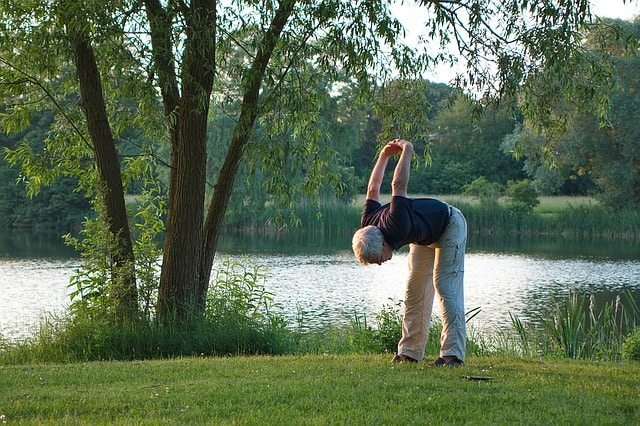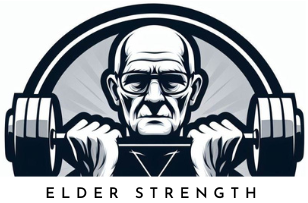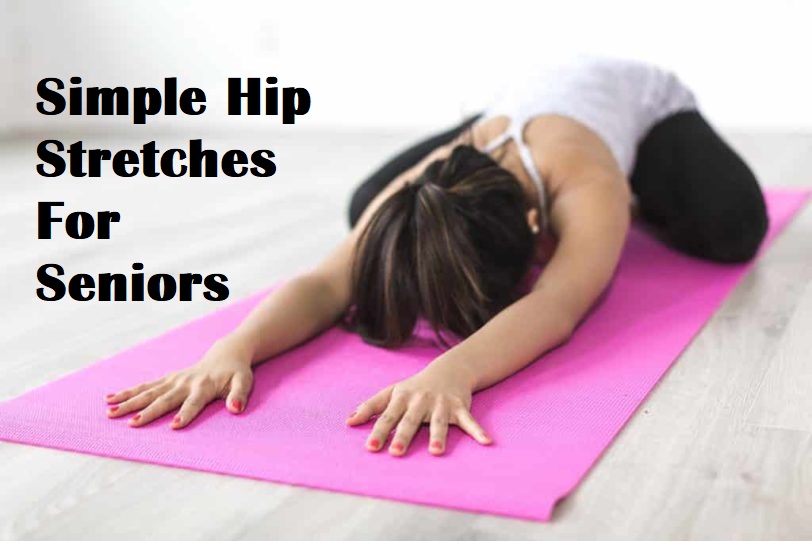In this article, you will learn about the importance of hip mobility and look at some simple hip stretches for seniors and the elderly.
Hip mobility is extremely important for a strong and functional body. Your leg strength, stability, and balance depend on the mobility of your hips. Any mobility issues or tightness in the hip area will limit your ability to move and maintain balance.
Seniors and elderly people often suffer from both muscle tightness and weakness in the hip area. It’s also not uncommon that people haven’t learned how to activate and use their hips correctly during their whole life.
This is because modern-day life doesn’t necessarily require you to use your hips correctly.
You can choose to move around with a car and sit in an office chair or the couch your whole life. Unfortunately, this can lead to all kinds of issues with the functioning and health of your body.
As we age it’s typical to move even less and avoid activities that require athletic movements and the proper usage of your hip and leg muscles.
Why Hip Mobility Is Important
The hips are the powerhouse of our body. Full body strength, power, and athletic capability all originate from the hips and the legs.
If the hips are not utilized correctly, you will lack a lot of strength potential. And you will put unnecessary strain on your lower back and knees, which have to compensate for the weak hips.
Improving hip strength and function start with improving hip mobility. Before we can start to strengthen the muscles, they need to have a good range of motion.
Hips have a large and complex range of motion. They are a ball-and-socket joint that can move and rotate in several directions. It’s important to sort out any mobility issues by stretching before we start to learn the movement patterns to strengthen the hips.
Once you have the required mobility and movement patterns ingrained you can start loading the movements with external weight to improve strength. If this is not done correctly, many people will end up doing movements like squats and deadlifts with round backs.
These same movement patterns are used every time you pick something heavy off the ground. Be it a bag of groceries, grandkids or the vacuum cleaner. Learning to use your hips correctly will save your back and knees and help you move more efficiently.
So as you can see, hip mobility is extremely important for the overall functionality of your body. Let’s start by looking at the anatomy of the hips a bit.
Anatomy of the hips
The “hips” is general term describing the anatomical area of the hip joints, the pelvis, and all the muscles that move them. In some instances, this can include the muscles of the back and abdomen that are responsible for tilting the pelvis in relation to the spine.
For the sake of simplicity, we will leave those muscle groups out of our discussion today and think of the hips as the hip joints and the muscles that move them.
The hip joint is a ball-and-socket joint that is extremely mobile. The femur can be moved in all directions in several planes and rotated on its axis for almost 90 degrees.
Besides being extremely mobile, the hip joint has to both statically (while standing) and dynamically (walking, jumping etc.) support our whole body weight. Not surprisingly, the muscles that connect to the hips are the largest and most powerful muscles in our body.

The most important muscle groups
The hip muscles which we are interested in today are the gluteals, the hamstrings, the hip flexors and the hip adductors.
Glutes
The gluteal muscles are responsible for hip extension, abduction and rotation. They are responsible for keeping you upright and producing explosive strength during lifting, jumping and sprinting. Glutes are typically very weak but not necessarily very tight with people who aren’t very active. This is because they are in a stretched position when you sit.
Hamstrings
The hamstrings are the large muscles that run from your hips to your knees at the back of your leg. They are responsible for hip extension with the glutes as well as flexing the knee. They are typically very tight and weak.
These are the muscles that usually restrict you the most when you do the classic mobility test of trying to touch the ground with straight legs.
Hamstrings are one of the strongest muscles groups in the body when trained correctly, but in many people they are almost atrophied. They typically get very sore if you have to use them and are not used to it.
You can learn more about hamstrings in the articles Hamstring Stretches For Seniors [Quick Guide] and Hip Strengthening Exercises For The Elderly [With Tips!].
Hip Flexors
The hip flexors consist of several muscles that are responsible for hip flexion which means raising your leg up or sitting you up, depending on the movement.
Hip flexors are typically very tight with people who sit a lot. Tight hip flexors can cause all sorts of issues and dysfunctions of the hips and lower back as they tend to tilt you hips especially if your glutes are weak as well.
You can learn more about the importance of hip flexors for posture in the articles Good Posture Exercises For Seniors, Exercises To Improve Posture In Elderly
Hip Adductors
The hip adductors are small muscles that bring your legs together. They are the least important of these muscle groups since their function is mainly to stabilize your gait.
But this makes them very important for balance. When you “pull a groin” you usually get a sprain in the adductors. It’s very easy to pull a groin while slipping or stumbling if you lack mobility and strength here.
Benefits of simple hip stretches for seniors
Because of the large range of motion and great forces the hips have to endure, they are prone to injuries and abrasion, which are common in seniors.
One of the best ways to prevent hip problems is to keep the surrounding muscles strong and limber so the joints function correctly. Using the muscles will also improve metabolism and regeneration of the joints and prevent osteoporosis.
Strength requires mobility and correct movement patterns. Hence, building your hip strength starts with improving hip mobility with stretching.
Falling is one of the leading causes of hospitalization of seniors. Your balance is dependent on the strength and mobility of your lower body. Without sufficient mobility, you can’t have a good balance as a senior.
Balance is also a skill, but your strength and mobility limit how well that skill works. So improving your hip mobility will improve your capacity to improve your balance, if that makes sense.
Hip mobility and balance are both very important for fall prevention. You can learn more about this in the articles Fall Prevention Exercises For Seniors [3 Exercises] and How To Prevent Falls In The Elderly [6 Tips]
Stretching helps you relax and improve the circulation of your legs as well. Many seniors suffer from leg cramps and hip pain. Having good mobility can improve these issues, especially when combined with strength training and other exercise.
The following routine is best done several times a week. Before bed for example, because it helps you relax. You can do it daily in the beginning to improve mobility faster and once your mobility is good, you can do them for three nights week for example.
Hip flexor stretch for seniors
Many seniors have problems with stretching their hip flexors. In the typical “couch stretch” where you lift your foot on a couch or a chair behind you and lunge forward with the other leg. This position requires quite a bit of mobility and strength just to get into position. If you lack either, you risk falling, pulling a groin, or simply failing to stretch the correct muscle.
You can do this simple hip flexor stretch sitting on a chair and is perfect for older people because of the added support. You sit on the edge of the seat sideways. Then bring your other foot behind your midline, so that your hip is fully extended.
Focus on keeping a neutral back. Don’t arch your lower back or slouch over. Bring the leg as far as comfortable with a good stretch. Never force the stretch.
Here’s a great example of the exercise by Yoga Vista (aka YogaJP) (YouTube embed. Content not owned or created by ElderStrength.com).
Hamstring stretches for the elderly
Typically hamstrings are stretched either one leg at a time by raising them on a chair or a table with a straight or slightly bent knee or simultaneously sitting on the floor, bending forwards with straight knees. Just like with the couch stretch, this requires enough mobility and balance to be performed safely and can prove to be too challenging for some older people.
These simple hamstring stretches are done sitting on a bench and require less balance and strength to perform. The important thing with hamstring stretches is to bend from the hips, not from the lower back. It’s very easy to miss this, so pay very close attention to your back.
(YouTube embed. Content not owned or created by ElderStrength.com).
Glute stretch for seniors
This simple glute stretch is effective for opening up the gluteal muscles. The important thing is to try and find the sweet spot where you feel a stretch on your glute. This requires your back remains neutral and get your legs in right positions. So don’t get discouraged if you don’t feel a stretch right away. Try again and take your time and you will get it!
Here’s a good explanation of the movements by ehowhealth (YouTube embed. Content not owned or created by ElderStrength.com):
Inner thigh (adductor) stretch for seniors
The adductors are relatively easy to stretch by sitting on the ground. Just bring your feet together and as close to your groin as your mobility allows.
You then bend forward while keeping your knees close to the ground and back neutral (bend from the hip). This should cause a nice stretch in the groin area.
Here’s a nice display of the stretch by LIVESTRONG.COM (YouTube embed. Content not owned or created by ElderStrength.com).
Conclusion
I hope you found the tips for simple hip stretches useful and will try them yourself. If you have any questions, please leave them in the comments section below and I will get back to you soon!
Having good mobility is paramount for improving hip function and preventing lower back, hip, and knee pain. By doing these simple stretches a few times a week, you can keep your hips mobile and limber indefinitely.
Leg strength is incredibly important because it is what allows you to move freely when you want to go. If you lose the mobility and strength of your legs, you will be at the mercy of other people.
There really can’t be a greater motivator to maintain your leg strength than freedom!
Thanks for reading and see you in the next article!

